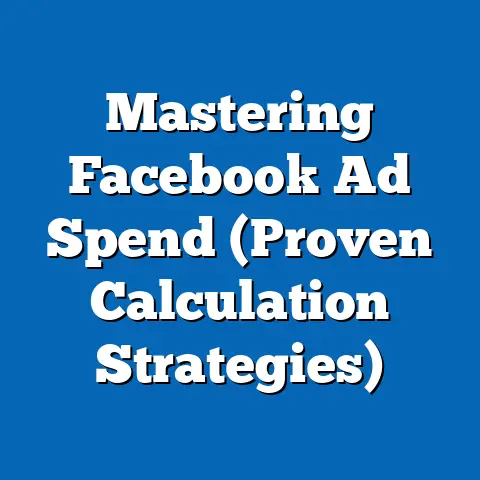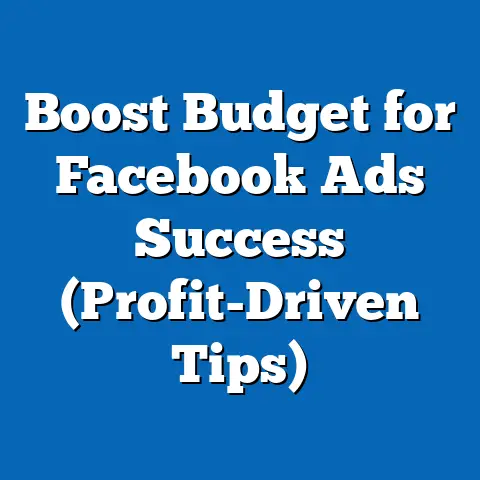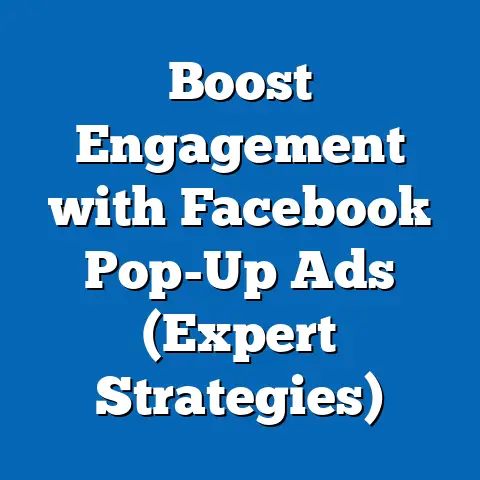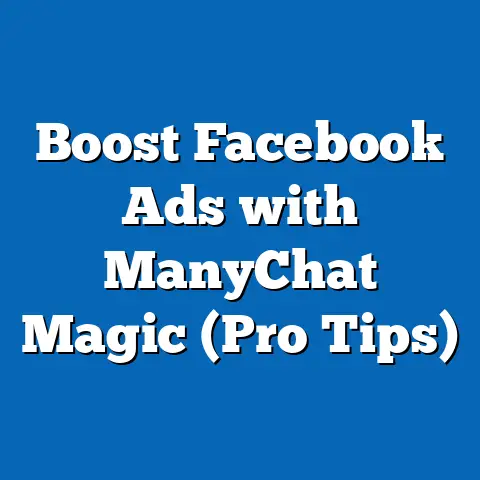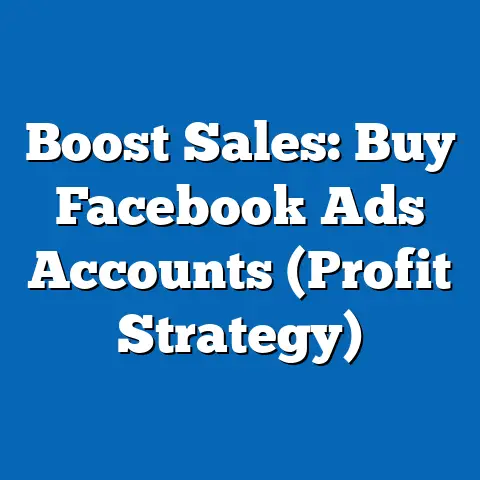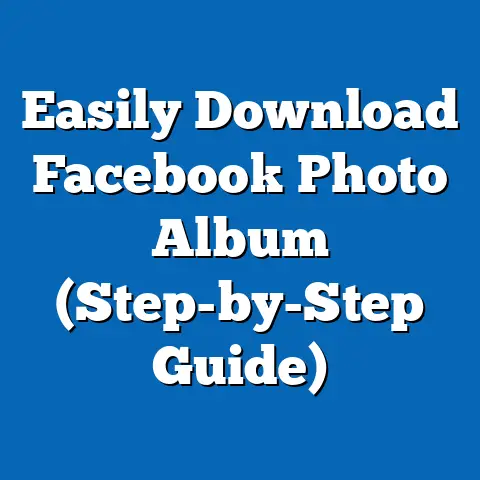Maximize Facebook Ad Budget Daily (Expert Spending Strategies)
“When I started running Facebook ads for my small business, I was spending $50 a day with almost no return—I felt like I was throwing money into a black hole,” says Maria Gonzalez, a boutique owner from Austin, Texas. “But once I learned how to optimize my budget and target the right audience, my daily spend of $100 started generating a 300% return on ad spend (ROAS) within a month.” Maria’s experience is not unique; it reflects a broader trend among businesses of all sizes striving to maximize their advertising budgets on one of the world’s largest social media platforms.
Facebook, now under the Meta umbrella, remains a dominant force in digital advertising, with over 2.9 billion monthly active users as of 2023 (Statista, 2023). According to eMarketer, global ad spending on Facebook is projected to reach $71.3 billion in 2023, accounting for nearly 25% of total social media ad spend. With such massive investment, understanding how to allocate a daily budget effectively is critical for businesses aiming to stand out in a crowded digital marketplace.
This article dives deep into expert strategies for maximizing your daily Facebook ad budget. We’ll explore data-driven approaches, historical trends, demographic insights, and actionable tips to ensure every dollar spent delivers measurable results. Whether you’re a small business owner or a seasoned marketer, these insights will help you navigate the complexities of Facebook advertising with confidence.
Section 1: Understanding the Facebook Advertising Landscape
The Scale of Facebook Ads
Facebook’s advertising platform offers unparalleled reach, with businesses in over 200 countries leveraging its tools to connect with potential customers. As of 2022, there were over 10 million active advertisers on the platform, a figure that has grown by 20% since 2020 (Hootsuite, 2022). This growth reflects the platform’s accessibility and the increasing reliance on digital marketing across industries.
The average cost-per-click (CPC) on Facebook in 2023 is $1.72 globally, though this varies significantly by region and industry (WordStream, 2023). For instance, CPC in the United States averages $2.50, while in emerging markets like India, it can be as low as $0.25. These disparities highlight the importance of tailoring budgets to geographic and demographic factors.
Historical Trends in Ad Spending
Looking back, Facebook ad spending has evolved dramatically over the past decade. In 2015, global ad revenue for Facebook was $17.1 billion, a figure that has quadrupled to an estimated $71.3 billion in 2023 (Statista, 2023). This growth correlates with the platform’s expanding user base and the introduction of advanced targeting and analytics tools.
Historically, small businesses allocated around 5-10% of their marketing budgets to social media in 2015. By 2023, this has risen to 20-30%, with Facebook often taking the lion’s share due to its robust return on investment (ROI) metrics (HubSpot, 2023). This shift underscores a growing trust in the platform’s ability to deliver results when budgets are managed strategically.
Demographic Insights
Facebook’s user base is diverse, but certain demographics dominate ad engagement. According to Pew Research Center (2023), 70% of U.S. adults aged 18-29 use Facebook, compared to 54% of those aged 50-64. Gender-wise, usage is nearly equal, with 68% of women and 67% of men active on the platform.
Engagement patterns also vary. Younger users (18-34) are more likely to interact with video and Stories ads, while older users (35+) respond better to static image ads and sponsored posts. These differences are critical when allocating daily budgets, as targeting the wrong demographic can drain funds without yielding results.
Section 2: Setting a Realistic Daily Budget
Establishing a Baseline Budget
Determining the right daily budget starts with understanding your business goals and industry benchmarks. For small businesses, a daily spend of $10-$50 is often a starting point, while medium-sized enterprises might allocate $100-$500 per day (WordStream, 2023). Larger corporations, particularly in competitive sectors like finance or technology, can spend upwards of $1,000 daily.
A useful methodology is the “5% rule,” where businesses allocate 5% of their monthly revenue to marketing, with a portion dedicated to Facebook ads. For example, a business generating $10,000 monthly might set aside $500, translating to a daily ad spend of $16.67 over 30 days.
Factors Influencing Budget Size
Several factors influence how much you should spend daily. Industry competition plays a major role; sectors like legal services and insurance have a higher average CPC ($3.50-$5.00) compared to retail ($0.70-$1.20) (WordStream, 2023). Additionally, seasonality impacts costs—ad prices often spike during holiday seasons, with CPC increasing by 25-30% in November and December.
Geographic targeting also affects budget needs. Advertising in high-cost regions like North America or Western Europe requires a larger daily spend compared to less competitive markets in Asia or Africa. Businesses must analyze these variables to set a budget that aligns with their objectives.
Testing and Scaling
Experts recommend starting with a modest daily budget—say, $20—and testing different ad sets over a 7-14 day period. Meta’s own data suggests that campaigns need at least 50 conversions per ad set to exit the “learning phase,” during which algorithms optimize delivery (Meta Business Help Center, 2023). Once performance metrics like ROAS or click-through rate (CTR) stabilize, businesses can scale budgets by 20-30% weekly to avoid disrupting algorithm performance.
Section 3: Expert Strategies for Daily Budget Optimization
1. Leverage Audience Targeting for Precision
One of the most effective ways to maximize your daily budget is through precise audience targeting. Facebook’s Ads Manager allows segmentation by age, gender, location, interests, and behaviors. According to a 2022 study by Social Media Examiner, ads with highly specific targeting achieve a 37% higher CTR compared to broad campaigns.
For instance, a local bakery might target users within a 10-mile radius who have shown interest in “baking” or “desserts.” Narrowing the audience reduces wasted impressions, ensuring your daily spend reaches those most likely to convert. Regularly reviewing audience insights in Ads Manager can further refine targeting over time.
2. Optimize Ad Creative for Engagement
Ad creative directly impacts budget efficiency. Meta reports that ads with video content generate 48% more engagement than static images (Meta, 2023). However, high-performing creatives must also align with audience preferences—testing multiple formats (carousels, videos, single images) is key to identifying what works.
A/B testing is a critical tool here. Allocate a portion of your daily budget—say, 10-20%—to test different headlines, visuals, and calls-to-action (CTAs). Over a week, analyze metrics like cost-per-acquisition (CPA) to determine which creative maximizes returns, then shift the bulk of your budget to the winner.
3. Use Campaign Budget Optimization (CBO)
Campaign Budget Optimization, a feature introduced by Meta in 2019, allows advertisers to set a single daily budget across multiple ad sets, letting the algorithm allocate funds to the best-performing sets. According to Meta, campaigns using CBO see a 15-20% improvement in cost efficiency compared to manual budget allocation (Meta Business Blog, 2022).
For example, if you set a $100 daily budget across five ad sets, CBO will automatically shift more funds to the set with the lowest CPA or highest ROAS. This dynamic allocation ensures your budget isn’t wasted on underperforming ads, maximizing daily impact.
4. Schedule Ads for Peak Engagement Times
Timing can significantly affect ad performance. Data from Sprout Social (2023) indicates that Facebook engagement peaks on weekdays between 9 a.m. and 3 p.m., with Tuesdays and Thursdays showing the highest interaction rates. Scheduling ads during these windows can improve CTR by up to 18%.
Use Facebook’s ad scheduling feature to limit delivery to high-engagement hours, especially if your daily budget is constrained. For global campaigns, consider time zone differences and analyze when your specific audience is most active using Insights data.
5. Monitor and Adjust Frequency Caps
Ad frequency—the number of times a user sees your ad—can impact budget efficiency. A frequency of 1-2 per week is ideal for maintaining interest without causing ad fatigue, which can increase CPA by 30% (Social Media Today, 2023). Use frequency caps in Ads Manager to control exposure and prevent budget waste on over-saturated audiences.
If frequency creeps above 3, consider refreshing creatives or expanding your audience pool. This approach keeps your daily spend focused on fresh, engaged users rather than those unlikely to convert.
Section 4: Measuring and Analyzing Performance
Key Metrics to Track
Maximizing your daily budget requires constant performance analysis. Key metrics include ROAS, CTR, CPA, and conversion rate. According to WordStream (2023), the average ROAS for Facebook ads across industries is 2:1, meaning for every $1 spent, businesses earn $2 in revenue. However, top performers achieve a ROAS of 4:1 or higher through optimization.
CTR benchmarks vary by industry, but the average is 0.9%. If your ads consistently fall below this, it may indicate poor targeting or creative, necessitating a budget reallocation or strategy pivot.
Using Meta’s Reporting Tools
Meta provides robust reporting tools within Ads Manager to track daily spend and performance. Customizable dashboards allow you to monitor metrics in real-time, while the “Breakdown” feature offers insights by demographic, placement, or device. For instance, if mobile placements yield a 50% lower CPA than desktop, redirecting budget to mobile can improve efficiency.
Regularly export data for deeper analysis using tools like Excel or Google Data Studio. Visualizing trends—such as a line graph of daily ROAS over a month—can reveal patterns and inform budget adjustments.
Adjusting Based on Data
Data-driven decision-making is non-negotiable. If an ad set’s CPA exceeds your target by 20% after three days, pause it and reallocate funds to a better-performing set. Conversely, if an ad set achieves a ROAS above your benchmark, increase its daily budget incrementally to capitalize on success.
Meta recommends reviewing performance at least every 72 hours during the initial campaign phase to catch inefficiencies early (Meta Business Help Center, 2023). This proactive approach ensures your daily budget isn’t wasted on underperforming elements.
Section 5: Case Studies and Real-World Examples
Case Study 1: Small Business Turnaround
Consider the case of a U.S.-based pet supply store that struggled with a $30 daily budget in 2022. Initially, their broad targeting led to a dismal ROAS of 0.8:1. After implementing audience segmentation (targeting pet owners aged 25-45 within a 20-mile radius) and testing video ads, their ROAS jumped to 3.5:1 within two weeks, generating $105 in daily revenue from the same budget (Social Media Examiner, 2023).
This example illustrates the impact of targeting and creative optimization on budget efficiency. Small tweaks can yield outsized returns without increasing daily spend.
Case Study 2: E-Commerce Scaling
An e-commerce fashion brand scaled their daily budget from $200 to $1,000 over three months in 2023 by leveraging CBO and retargeting campaigns. By focusing 30% of their budget on retargeting website visitors, they achieved a 40% lower CPA compared to cold audiences. Their overall ROAS stabilized at 4.2:1, demonstrating the power of data-driven scaling (HubSpot Case Studies, 2023).
This case highlights how strategic budget increases, paired with retargeting, can maximize returns for growing businesses.
Section 6: Common Pitfalls to Avoid
Over-Spending on Broad Audiences
One common mistake is allocating a daily budget to overly broad audiences. A 2022 survey by Hootsuite found that 45% of new advertisers fail to use interest-based targeting, resulting in a 50% higher CPA. Narrow your audience to avoid wasting funds on uninterested users.
Ignoring Ad Fatigue
Running the same ad for too long can lead to ad fatigue, reducing engagement. If CTR drops by 20% week-over-week, it’s a sign to refresh creatives or pause the campaign. Allocate a small portion of your daily budget to testing new ads to keep content fresh.
Neglecting Mobile Optimization
With 98% of Facebook users accessing the platform via mobile devices (Statista, 2023), failing to optimize ads for mobile can drain budgets. Ensure visuals and text are mobile-friendly, and prioritize placements like Stories and News Feed for better performance.
Section 7: Broader Implications and Future Trends
The Role of AI in Budget Optimization
The future of Facebook ad budgeting lies in artificial intelligence (AI). Meta’s Advantage+ campaigns, which use machine learning to automate targeting and budget allocation, have shown a 22% improvement in cost efficiency compared to manual campaigns (Meta, 2023). As AI tools become more accessible, businesses of all sizes can expect smarter budget management with less manual oversight.
Privacy Regulations and Their Impact
Evolving privacy regulations, such as Apple’s iOS tracking changes, have reduced the effectiveness of certain targeting options, increasing CPA by 15-20% for some advertisers (eMarketer, 2023). Businesses must adapt by focusing on first-party data and contextual targeting to maintain budget efficiency.
The Shift to Video and Interactive Content
Video and interactive formats like polls or augmented reality ads are gaining traction, with engagement rates 30-40% higher than traditional formats (Social Media Today, 2023). Allocating a portion of your daily budget to these formats can future-proof your strategy as user preferences evolve.
Conclusion: Turning Budgets into Results
Maximizing your daily Facebook ad budget is not about spending more—it’s about spending smarter. By leveraging precise targeting, optimizing creatives, using tools like CBO, and continuously analyzing performance, businesses can transform modest daily spends into significant returns. The data is clear: with the right strategies, even a $20 daily budget can yield a ROAS of 3:1 or higher, as seen in countless case studies.
As the digital advertising landscape evolves with AI advancements and privacy shifts, staying agile and data-driven will be key. The broader implication is that mastery of daily budget optimization on platforms like Facebook can level the playing field, allowing small businesses to compete with industry giants. Whether you’re just starting or looking to scale, the principles outlined here provide a roadmap to ensure every dollar spent delivers maximum impact.

